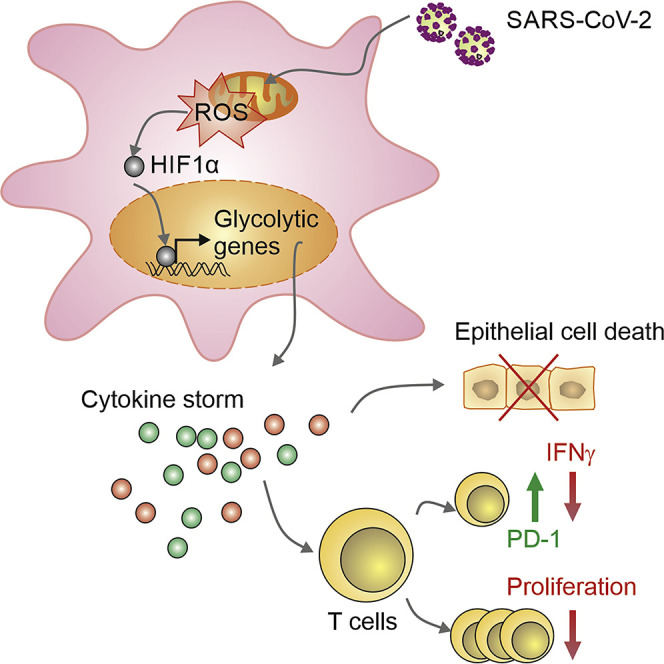Elevated Glucose Levels Favor SARS-CoV-2 Infection and Monocyte Response through a HIF-1α/Glycolysis-Dependent Axis.
COVID-19 can result in severe lung injury. It remained to be determined why diabetic individuals with uncontrolled glucose levels are more prone to develop the severe form of COVID-19. The molecular mechanism underlying SARS-CoV-2 infection and what determines the onset of the cytokine storm found in severe COVID-19 patients are unknown. Monocytes and macrophages are the most enriched immune cell types in the lungs of COVID-19 patients and appear to have a central role in the pathogenicity of the disease. These cells adapt their metabolism upon infection and become highly glycolytic, which facilitates SARS-CoV-2 replication. The infection triggers mitochondrial ROS production, which induces stabilization of hypoxia-inducible factor-1α (HIF-1α) and consequently promotes glycolysis. HIF-1α-induced changes in monocyte metabolism by SARS-CoV-2 infection directly inhibit T cell response and reduce epithelial cell survival. Targeting HIF-1ɑ may have great therapeutic potential for the development of novel drugs to treat COVID-19.
Authors
Ana Campos Codo; Gustavo Gastão Davanzo; Lauar de Brito Monteiro; Gabriela Fabiano de Souza; Stéfanie Primon Muraro; João Victor Virgilio-da-Silva; Juliana Silveira Prodonoff; Victor Corasolla Carregari; Carlos Alberto Oliveira de Biagi Junior; Fernanda Crunfli; Jeffersson Leandro Jimenez Restrepo; Pedro Henrique Vendramini; Guilherme Reis-de-Oliveira; Karina Bispo Dos Santos; Daniel A Toledo-Teixeira; Pierina Lorencini Parise; Matheus Cavalheiro Martini; Rafael Elias Marques; Helison R Carmo; Alexandre Borin; Laís Durço Coimbra; Vinícius O Boldrini; Natalia S Brunetti; Andre S Vieira; Eli Mansour; Raisa G Ulaf; Ana F Bernardes; Thyago A Nunes; Luciana C Ribeiro; Andre C Palma; Marcus V Agrela; Maria Luiza Moretti; Andrei C Sposito; Fabrício Bíscaro Pereira; Licio Augusto Velloso; Marco Aurélio Ramirez Vinolo; André Damasio; José Luiz Proença-Módena; Robson Francisco Carvalho; Marcelo A Mori; Daniel Martins-de-Souza; Helder I Nakaya; Alessandro S Farias; Pedro M Moraes-Vieira
External link
Publication Year
Publication Journal
Associeted Project
Systems Immunology of Human Diseases
Lista de serviços
-
StructRNAfinder: an automated pipeline and web server for RNA families prediction.StructRNAfinder: an automated pipeline and web server for RNA families prediction.
-
CEMiTool: a Bioconductor package for performing comprehensive modular co-expression analyses.CEMiTool: a Bioconductor package for performing comprehensive modular co-expression analyses.
-
webCEMiTool: Co-expression Modular Analysis Made Easy.webCEMiTool: Co-expression Modular Analysis Made Easy.
-
Assessing the Impact of Sample Heterogeneity on Transcriptome Analysis of Human Diseases Using MDP Webtool.Assessing the Impact of Sample Heterogeneity on Transcriptome Analysis of Human Diseases Using MDP Webtool.
-
Predicting RNA Families in Nucleotide Sequences Using StructRNAfinder.Predicting RNA Families in Nucleotide Sequences Using StructRNAfinder.
-
OUTBREAK: a user-friendly georeferencing online tool for disease surveillance.OUTBREAK: a user-friendly georeferencing online tool for disease surveillance.
-
Noninvasive prenatal paternity determination using microhaplotypes: a pilot study.Noninvasive prenatal paternity determination using microhaplotypes: a pilot study.
-
Editorial: User-Friendly Tools Applied to Genetics or Systems Biology.Editorial: User-Friendly Tools Applied to Genetics or Systems Biology.
-
Automatic detection of the parasite Trypanosoma cruzi in blood smears using a machine learning approach applied to mobile phone imagesAutomatic detection of the parasite Trypanosoma cruzi in blood smears using a machine learning approach applied to mobile phone images
-
Tucuxi-BLAST: Enabling fast and accurate record linkage of large-scale health-related administrative databases through a DNA-encoded approachTucuxi-BLAST: Enabling fast and accurate record linkage of large-scale health-related administrative databases through a DNA-encoded approach
-
Ten quick tips for harnessing the power of ChatGPT in computational biologyTen quick tips for harnessing the power of ChatGPT in computational biology

